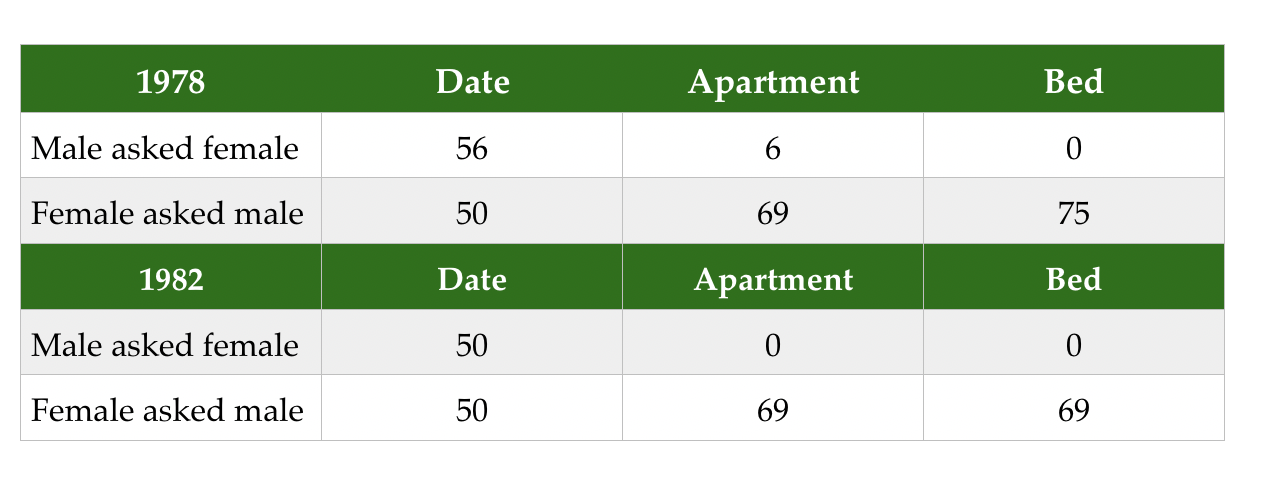Clark and Hatfield (1989)
 Evolutionary psychologists attempt to explain human mating and sexual behaviour by the theory of natural selection. The theory argues that for men it is all about spreading one's DNA and for women it is all about maximizing the potential for survival for her fertilized egg.
Evolutionary psychologists attempt to explain human mating and sexual behaviour by the theory of natural selection. The theory argues that for men it is all about spreading one's DNA and for women it is all about maximizing the potential for survival for her fertilized egg.
The following study by Clark and Hatfield is an interesting field experiment that looks to see if there really are gender differences in the approach to casual sexual activity. The study's findings can be explained by the theory of natural selection.
The parental investment theory argues that natural selection can account for sex differences in infidelity. The theory postulates that women, who typically invest more time and energy into raising their offspring, are more choosy when it comes to mate selection. Women are looking for a partner who has the resources - both physical and material - that will protect their offspring. Men, however, have less parental investment. They are more interested in simply increasing their chance of spreading their DNA. This means that the more sexual activity that they have, the greater the chance of reproduction.
The following study by Clark and Hatfield seems to support the parental investment theory, finding that men are more willing to engage in casual sexual activity, whereas women are a bit more choosy.
The publication of this study is actually the publication of two experiments. The first experiment was carried out in 1978 and a replication of that study was carried out in 1982. The results in both experiments were the same.
In both studies, the sample was made up of 48 male and 48 female participants. The study also used a team of confederates (five women and four men) who ranged from mildly unattractive to moderately attractive.
The confederates approached members of the opposite sex who were total strangers. The confederates were told to only approach people that they thought were attractive enough that they would be willing to actually sleep with them. They were asked after each interaction to rate the attractiveness of the naive participants. There was no significant difference between the two gender groups.
Once they had selected a participant, the confederate would say, "I have been noticing you around campus. I find you very attractive." Then they would ask one of the following questions:
- Would you go out with me tonight?
- Would you come over to my apartment tonight?
- Would you go to bed with me tonight?
The questions were asked randomly. They were also only asked during weekdays and not between classes or during rainy weather.
All participants were debriefed.
The percent of participants who agreed with the request can be seen in the table below.

Notice that although in both cases roughly 70% of the men were willing to have casual sex, in both experiments, none of the women agreed to do so. Analysis of the results found that the level of attractiveness of the confederate and no significant impact on the response from the participant.
The 1982 replication obtained the same results as the original study, indicating that the results may be reliable.
The study is a field experiment. The participants were randomly allocated to one of the three conditions - date, apartment, or bed. The study had high ecological validity because it was done under naturalistic conditions; however, deception was used, which is an ethical concern.
Although the results are interesting, the parental investment theory is only one possible explanation for why the difference exists. It could also be attributed to social norms. This study was done in Florida. It is possible that a society with different social norms would have different results. It could also be that women have more concerns about safety when asked for casual sex by a stranger. Men may be more confident in their ability to deal with any type of entrapment or physical assault than women.
The study was also done prior to the AIDS epidemic and to the sexual revolution of the early 2000s. Therefore, the study may lack temporal validity. However, modern replications in the US have yielded similar results.

 IB Docs (2) Team
IB Docs (2) Team
